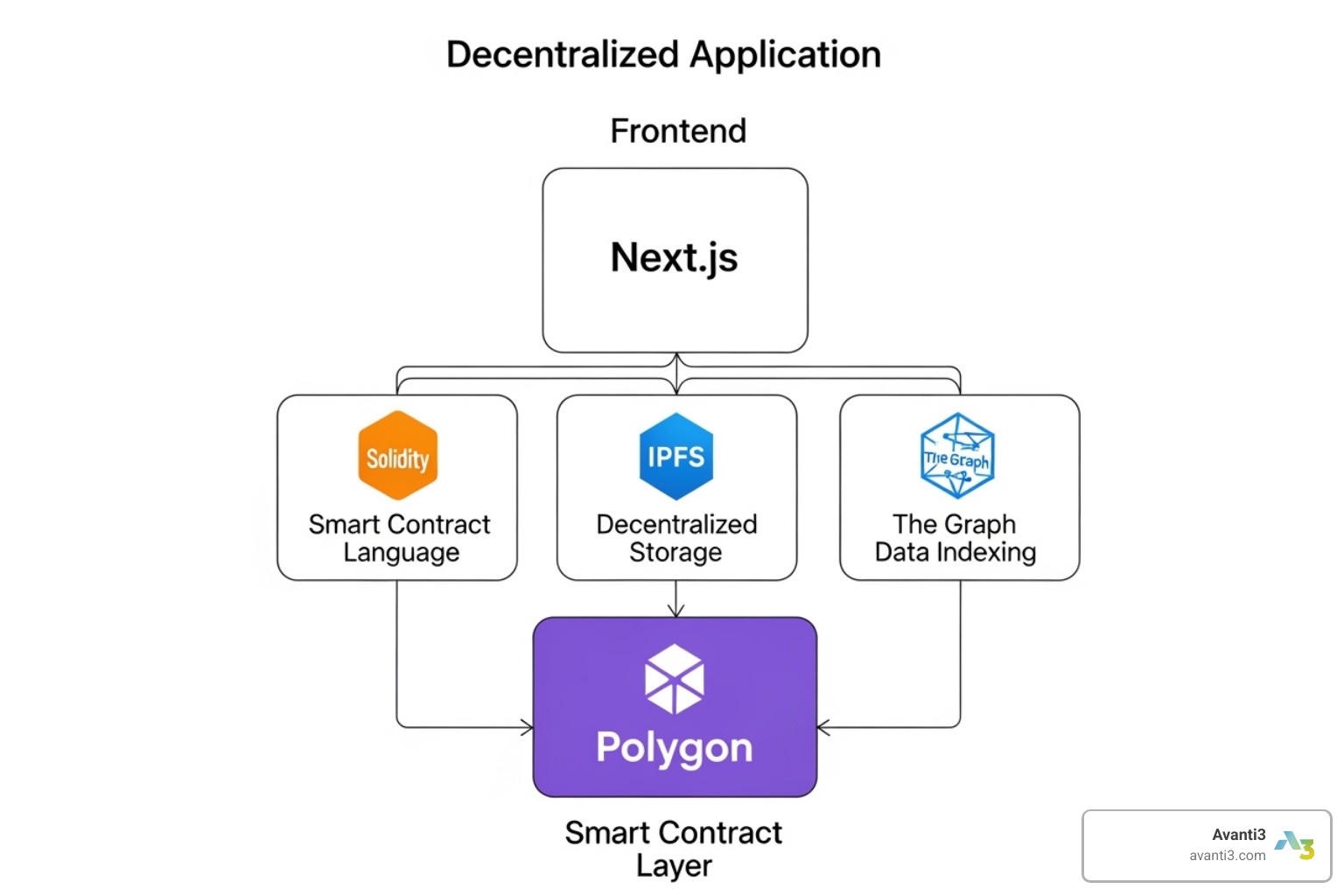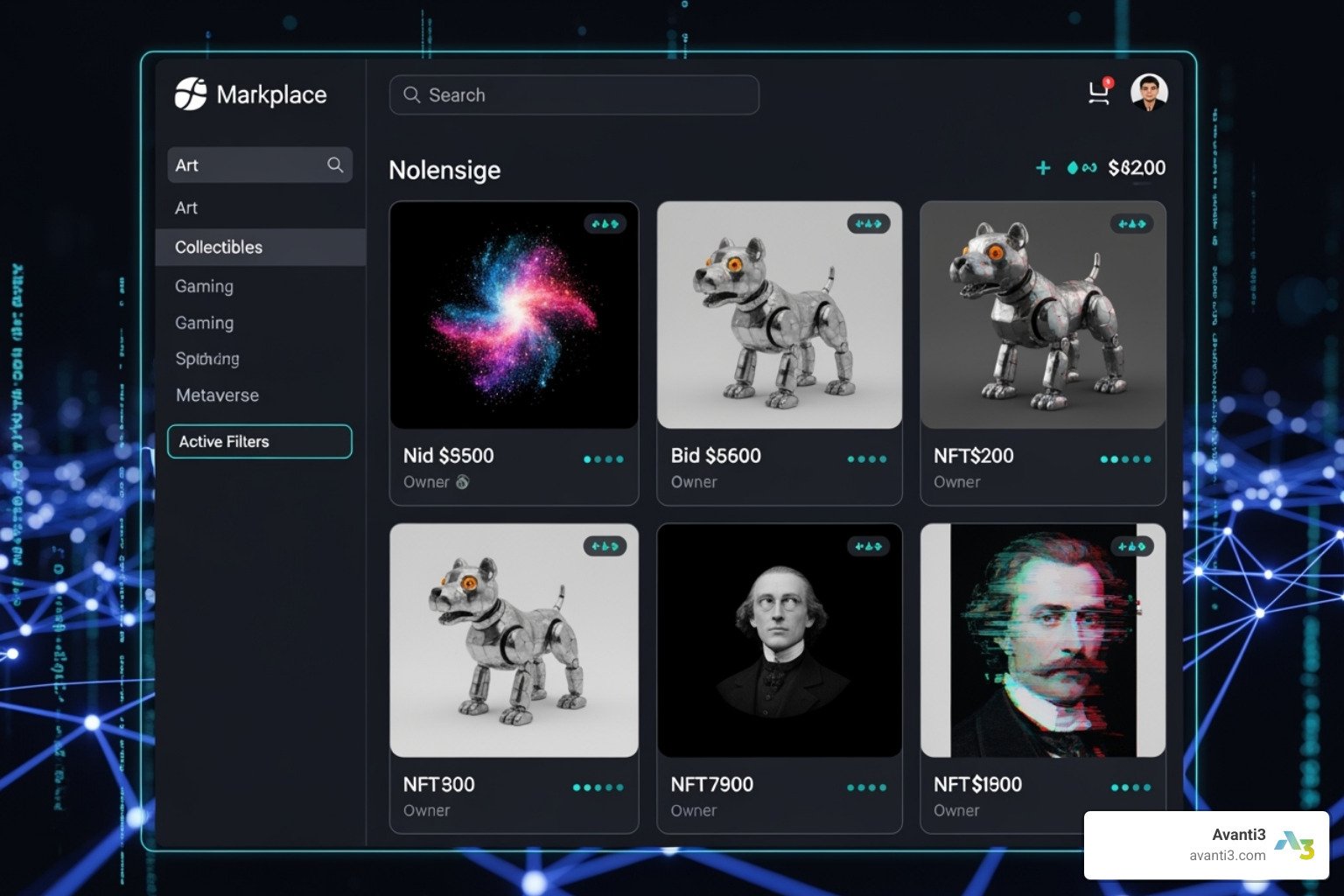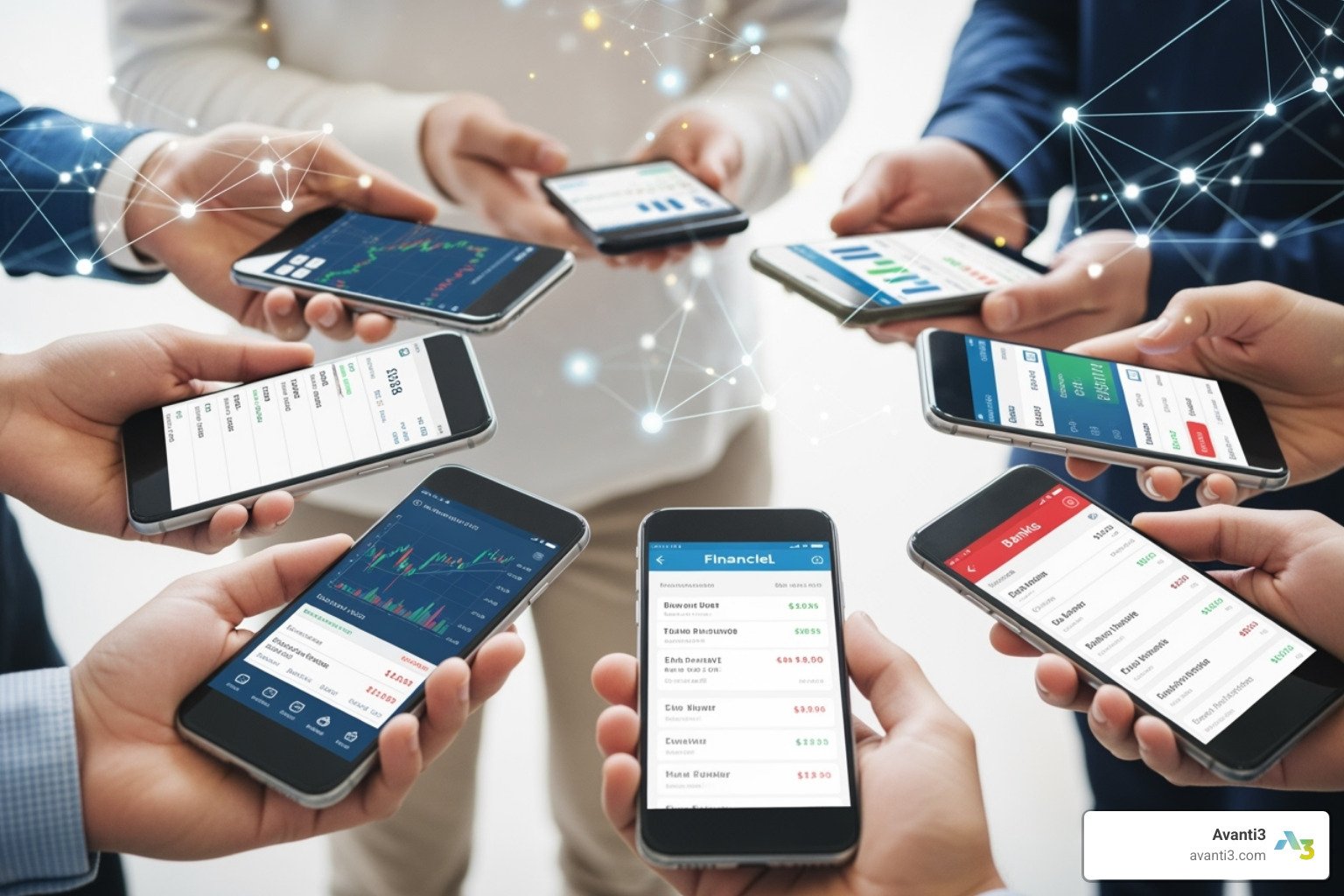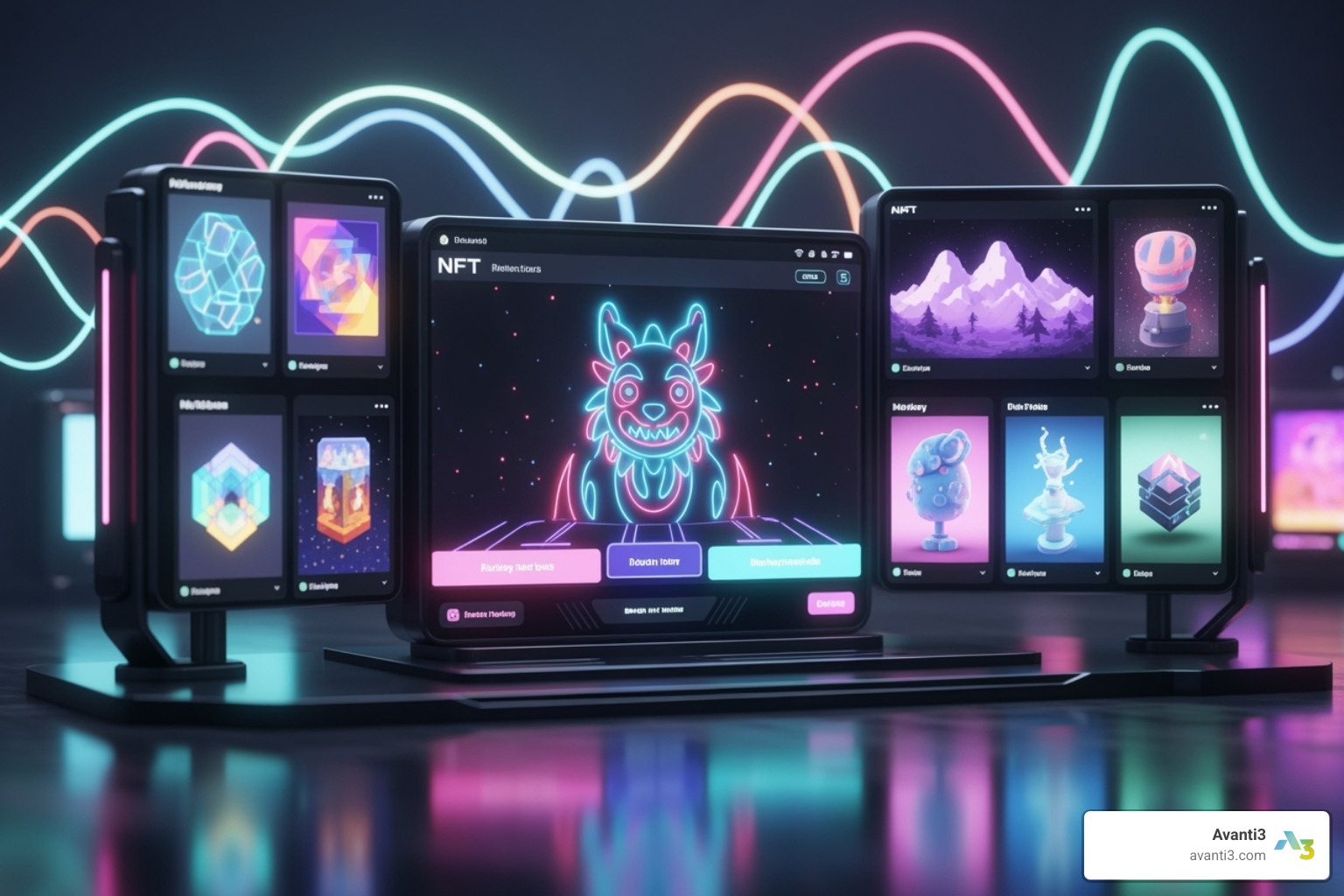Full Stack NFT Marketplace 2025: Unleash Success
Why Full Stack NFT Marketplaces Are Revolutionizing Digital Commerce
A full stack nft marketplace combines blockchain, smart contracts, and modern web development into a complete digital trading platform. These solutions handle everything from NFT creation and storage to user interfaces and transaction processing.
Key Components of a Full Stack NFT Marketplace:
- Frontend: User interface built with React/Next.js for browsing and trading
- Smart Contracts: Solidity-based contracts handling minting, listing, and sales
- Backend Services: APIs for metadata management and user authentication
- Blockchain Integration: Connection to networks like Ethereum, Polygon, or Solana
- Storage Solutions: IPFS for decentralized file storage
- Indexing: The Graph protocol for querying blockchain data
The NFT market reached $3.5 billion in 2021 and continues growing rapidly. Unlike traditional marketplaces, full stack solutions give creators complete control over their digital assets, fees, and community engagement.
Building a full stack nft marketplace requires combining web development skills with blockchain knowledge. You’ll need to understand smart contract development, wallet integration, and decentralized storage systems.
My experience with full stack nft marketplace development has shown how these platforms can transform creator monetization and community building.
Full stack nft marketplace terms explained:
The Core Building Blocks of a Full Stack NFT Marketplace
Building a full stack nft marketplace requires every layer to work together perfectly, combining modern web development with the power of blockchain. The magic happens when sleek user interfaces are combined with smart contracts, decentralized storage, and fast data indexing to create an ecosystem where digital assets can be minted, traded, and treasured.

Choosing your blockchain foundation is a critical decision that affects everything from daily costs to the community you attract. Ethereum is a popular choice, but high gas fees have led to alternatives like Polygon, which offers the same capabilities with lower transaction costs and faster speeds.
Solana brings impressive speed to the table, while platforms like Celo focus on mobile-first experiences. Each blockchain has its own personality—some prioritize security, others focus on speed, and some aim for the perfect balance of both.
The key is matching your platform choice to your audience’s needs and your budget reality. Want to learn more about securing digital assets? Check out our insights on Blockchain Art Authentication.
Frontend & UI/UX: The User’s Gateway
Your frontend is where the magic meets the user. A great user experience is everything—it’s the difference between a visitor staying to explore and clicking away in confusion. Your full stack nft marketplace should feel like an inviting art gallery, not a confusing maze.
We typically build these experiences using Next.js and React because they create fast, smooth interfaces that work well on both phones and computers. Next.js gives us those lightning-fast page loads that keep users happy and search engines satisfied.
Wallet connection is where Web3 gets real. Libraries like RainbowKit and Wagmi transform what used to be a developer nightmare into a simple, neat experience. Users just click “Connect Wallet,” choose their favorite option (usually MetaMask), and boom – they’re ready to trade.
The essential components that make users feel at home include an engaging NFT gallery where beautiful art takes center stage, a prominent search bar that actually finds what people want, a crystal-clear wallet connect button that doesn’t hide in a corner, and a personalized profile page where users can admire their collection and track their trading history.
These aren’t just features – they’re the building blocks of trust and engagement. For more ways to keep your community engaged, explore our NFT Engagement Tools.
Backend & Smart Contracts: The Engine of Your Full Stack NFT Marketplace
If the frontend is the friendly face, smart contracts are the trustworthy backbone. They showcase blockchain’s power by creating self-executing agreements without middlemen. Smart contracts written in Solidity handle the heavy lifting in your full stack nft marketplace, managing everything from NFT creation and sales to creator royalties.
We use development frameworks like Hardhat or Truffle to build and test these contracts. Think of them as our coding workshop – they help us write better code, test it thoroughly, and deploy it safely.
Token standards matter more than you might think. ERC-721 creates unique, one-of-a-kind NFTs (perfect for digital art), while ERC-1155 can handle both unique items and collections of similar pieces. We often use OpenZeppelin libraries because they’ve already solved the hard security problems for us. You can learn more about the ERC721 standard to dive deeper.
The core functions that make everything work include minting (creating brand new NFTs on the blockchain), listing (putting NFTs up for sale with prices and terms), buying (handling the exchange of crypto for digital assets), and royalties (automatically paying creators when their work gets resold).
Security isn’t optional – it’s absolutely critical. We test everything on testnets first, follow strict coding practices, and strongly recommend professional audits before launching. One small bug could mean lost funds or broken trust.
For storing the actual images and metadata, we turn to IPFS (InterPlanetary File System). It keeps files decentralized and permanent, so your NFTs won’t disappear if a single server goes down.
Indexing Blockchain Data with The Graph
A common developer challenge is that blockchains, while secure, are inefficient for data querying. It’s like trying to find an item in a store where everything is in locked boxes you can only open one at a time.
The Graph protocol solves this headache beautifully. It watches your smart contracts, notices when important things happen (like NFTs being listed or sold), and organizes all that information into a searchable database.
Subgraphs are where the magic happens. These are like custom search engines for your marketplace data. Instead of asking the blockchain “show me all active listings” and waiting forever for an answer, you can ask your subgraph and get instant results.
Here’s how it works in practice: your smart contracts emit events whenever something important happens, your subgraph configuration tells The Graph which events to watch for, your schema definition organizes how the data should look, and handler functions written in AssemblyScript process each event and store the useful information.
The result? Your frontend can use GraphQL queries to ask complex questions like “show me all NFTs under $100 from this artist” and get answers instantly. It transforms your full stack nft marketplace from sluggish to lightning-fast.
Real-time data updates mean your users always see the latest information, whether something just got listed or sold. No more stale data or confused customers wondering if that NFT is still available.
Want to explore this further? Check out The Graph’s hosted service to see how powerful this indexing can be.
From Code to Community: Launching and Growing Your Marketplace

Think of this phase as throwing a digital house-warming party. You’ve built the house (your marketplace), but now you need to invite people over and create an atmosphere where everyone wants to stay. That’s where our expertise in digital brand engagement becomes invaluable – helping you connect authentically with creators and collectors who will make your platform thrive.
The truth is, building a successful marketplace isn’t just about having the best smart contracts or the prettiest interface. It’s about fostering genuine relationships and creating value for real people.
Deployment, Security, and Launch Best Practices
Rolling out your full stack nft marketplace requires precision. It’s a methodical process that starts small and scales thoughtfully, not just flipping a switch and hoping for the best.
Your deployment journey begins in the safe harbor of testnets. Here, you can break things, fix them, and break them again without anyone losing real money or valuable NFTs. It’s like a practice stage before the main performance. Once you’re confident, you’ll graduate to the mainnet where real transactions happen.
| Feature | Testnet Deployment | Mainnet Deployment |
|---|---|---|
| Purpose | Testing functionality, bug fixing, validating smart contract interactions. | Live, production environment for real-world transactions and user engagement. |
| Cost | Free (uses test tokens, no real gas fees). | Incurs real transaction costs (gas fees) and potentially other operational costs. |
| Risk | Low risk; no real assets are involved. | High risk; involves real user funds and valuable NFTs. |
| Environment | Simulated blockchain environment, often reset or less stable than mainnet. | Live, public blockchain network. |
| Key Use | Development iterations, integration testing, pre-launch bug squashing. | Public launch, facilitating actual trading and community interaction. |
For your frontend, Vercel makes deployment almost embarrassingly easy, especially with Next.js projects. Their seamless integration and automatic deployments from your Git repository mean you can focus on building features instead of wrestling with server configurations. AWS offers more control and scalability options if you need enterprise-level infrastructure.
Now, let’s talk about security. In the NFT world, a security breach can be financially devastating for your users and fatal for your platform’s reputation.
Smart contract audits are non-negotiable before mainnet launch. Yes, they cost money, but think of them as insurance for your entire project. Professional security firms will scrutinize every line of your Solidity code, hunting for vulnerabilities.
Beyond audits, you need rock-solid secure coding practices. This means validating all inputs, implementing proper access controls using proven libraries like OpenZeppelin, and optimizing for gas efficiency so your users aren’t hit with sky-high transaction fees.
Protecting user assets goes beyond smart contract security. Your wallet integration needs to be bulletproof, your API keys must be properly secured using environment variables, and every user interaction should be validated. You’re safeguarding people’s digital treasures and hard-earned money.
Monetization and Community Engagement
Your full stack nft marketplace must be financially sustainable while serving your community. It’s a delicate balance, but when done right, everyone wins.
Your monetization toolkit includes several proven strategies. Platform fees are the bread and butter – taking a small percentage of each sale keeps the lights on. Listing fees can work, but be careful not to price out emerging artists. Minting fees make sense if you’re offering creation tools, while featured listings let sellers pay for premium visibility. Don’t forget about royalties – while they don’t directly benefit your platform, enforcing creator royalties builds trust and attracts artists.
But here’s the secret sauce: community building is what transforms a functional marketplace into a cultural phenomenon. The most successful NFT platforms aren’t just trading venues – they’re gathering places where creators and collectors form genuine connections.
Social media integration isn’t optional. Your community will live on Discord and Twitter, sharing finds, celebrating launches, and supporting each other. These platforms become the heartbeat of your ecosystem.
Think about implementing gamified experiences that reward active participation. Users love earning badges, climbing leaderboards, or open uping special privileges. These elements, similar to loyalty programs, keep people engaged long after their first purchase. You can explore more about this approach by learning about digital community building and implementing a digital reward system.
Direct engagement through AMAs with popular creators, virtual gallery openings, or exclusive drops for community members creates memorable experiences. You’re not just facilitating transactions – you’re curating culture.
Conclusion: The Future of Digital Ownership
We’ve covered the journey of building a full stack nft marketplace, from choosing a blockchain and crafting interfaces to deploying secure smart contracts and nurturing communities. Each piece—Next.js, Solidity, IPFS, and The Graph—contributes to platforms that are reshaping digital ownership.
The NFT space isn’t slowing down – it’s evolving. We’re seeing incredible innovations like Augmented Reality NFTs that blur the lines between digital and physical experiences, creating new possibilities for creators and collectors.
This evolution is fundamentally changing the creator economy. Artists no longer need galleries or record labels to reach global audiences. They can mint their work, build direct relationships with fans, and earn ongoing royalties from secondary sales. It’s democratizing creativity in ways we’ve never seen before.
Challenges remain. Scalability questions, regulatory uncertainties, and environmental concerns are real issues the industry continues to address. But the rapid development of layer-2 solutions and the growing sophistication of Web3 tools suggest these problems are temporary.

At Avanti3, we’re passionate about empowering creators and brands with the Web3 tools they need to thrive. We believe the future belongs to platforms that combine cutting-edge technology with genuine human connection.
Building a full stack nft marketplace is ambitious, complex, and incredibly rewarding. You’re not just writing code or deploying contracts – you’re helping to build the infrastructure for digital ownership that will define how future generations create, share, and value art.
Ready to start building your vision? To start building your own platform, explore our expert NFT Marketplace Development services.







